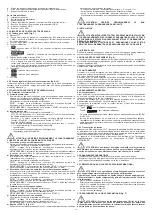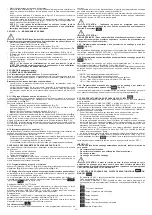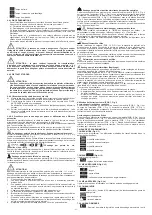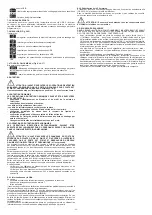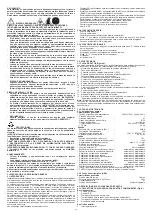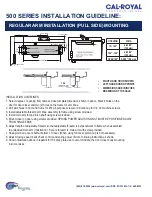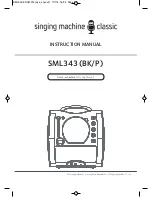
- 9 -
6.4.2.2 Procedure to spot weld and use various tools
Connect the studder gun and the earth cable to the clamp supplied, carefully following
the instructions sheet contained in the Studder kit.
Press the “START” button pressing the knob and select the tool you want to use (Fig.
U-1-10).
Select the material and the thickness of the sheet metal you want to weld (Fig. U-18).
Based on the tool selected, follow the procedures described below:
Washer spot welding for earth terminal fastening
On the chuck of the gun, assemble the specific electrode (POS.9, Fig. I) and insert the
washer (POS.13, Fig. I).
Rest the washer in the chosen zone. Place in contact, in the same zone, the earth
terminal; press the gun button implementing welding of the washer on which fastening
should be carried out as previously described.
Spot welding of screws, washers,
nails and rivets
Equip the gun of the suitable electrode by inserting the element on it to spot weld and
rest it on the sheet metal on the desired spot; press the button on the gun; release the
button only having passed the time set.
Sheet metal spot welding from one side only
On the gun chuck, assemble the electrode planned (POS.6, Fig. I) pressing on the
surface to spot weld. Activate the gun button, release the button only having passed
the time set.
WARNING!
Maximum thickness of the sheet metal for spot welding, from one side only: 1+1 mm.
This spot welding is not permitted on support structures of the bodywork.
To obtain correct spot welding results on the sheet metal, you need to take some
fundamental precautions:
1 - A perfect earth connection.
2 - The two parts to spot weld must be free of paint, grease and oil.
3 - The parts to spot weld must be in contact with one another, without air gaps, if
necessary press with a tool, not with the gun. Too heavy pressure leads to poor
results.
4 - The thickness of the upper part must not exceed 1 mm.
5 - The tip of the electrode must have a diameter of 2.5 mm.
6 - Tighten the nut well fastening the electrode, check the connectors of the welding
cable are fastened.
7 - Then spot weld, resting the electrode to exert light pressure (3÷4 kg). Press the
button and pass the spot welding time, only then move away with the gun.
8 - Never move more than 30 cm from the fastening point of the earth.
Spot welding and simultaneous traction of the special washers
This function should be carried out assembling and fully tightening the chuck (POS.4,
Fig. I) on the body of the extractor (POS.1, Fig. I), couple and tighten the other
terminal of the extractor on the gun (Fig. I). Insert the special washer (POS.14, Fig.
I) on the chuck (POS.4, Fig. I), fastening it with the specific screw (Fig. I). Spot weld
the relevant zone, adjusting the spot welding machine as for spot welding the washers
and start traction.
When complete, turn the extractor 90° to detach the washer, which can be spot welded
again in a new position.
Heating and sheet metal recalculation
In this operating mode, the TIMER is disabled by default: by selecting the welding
time, the display shows “
inf
” = Infinite time.
Operation duration is therefore manual, being determined by the time for which the
gun button is kept pressed.
Current intensity is adjusted automatically according to the thickness of the selected
sheet.
Sheet metal heating
Assemble the carbon electrode (POS. 12, Fig. I) on the gun chuck and block in place
with the ring nut. Touch the area, that was previously bared, with the carbon tip and
tighten with the gun button. Work from the outside to the inside, using a circular
movement to heat the sheet which undergoes work hardening and returns to its
original position.
To prevent the sheet from drawing too much, treat small areas and immediately after
wipe using a damp cloth to cool the treated part.
Sheet metal recalculation
In this position, working with the specific electrode, you can flatten the sheet metal that
underwent localised deformation.
Intermittent spot welding (patching)
This function is suitable for spot welding small rectangles of sheet metal to cover holes
due to rust or other causes.
Place the specific electrode (POS.5, Fig. I) on the chuck, accurately tighten the
fastening ring nut. Bare the relevant zone and ensure the piece of sheet metal you
want to spot weld is clean and free of grease or paint.
Position the piece and rest on the electrode, then push the gun button keeping the
button always pressed, advance rhythmically following the work/rest intervals given by
the spot welding machine.
NB: During the work, exert light pressure (3÷4 kg), working following an ideal line 2÷3
mm from the edge of the new piece to weld.
To obtain good results:
1 - Do not move more than 30 cm from the fastening point of the earth.
2 - Use coverage sheet metal with a maximum thickness of 0.8 mm, better if stainless
steel.
3 - Rhythm advanced movement with the frequency dictated by the spot welder.
Advance during the pause time, stop during spot welding time.
Use the extractor supplied (POS. 1, Fig. I)
Washer coupling and traction
This function is carried out by assembling and tightening the chuck (POS.3, Fig. I) on
the body of the electrode (POS.1, Fig. I). Couple the washer (POS.13, Fig. I), spot
welded as previously described, and start traction. In the end, rotate the extractor 90°
to detach the washer.
Plug coupling and traction
This function is carried out by assembling and tightening the chuck (POS.2, Fig. I)
on the body of the electrode (POS.1, Fig. I). Insert the plug (POS.15-16, Fig. I), spot
welded as previously described in the chuck (POS.1, Fig. I) keeping the terminal itself
pulled towards the extractor (POS.2, Fig. I). With insertion complete, release the chuck
and start traction. On completion, pull the chuck towards the hammer to remove the
plug.
7. SETTINGS MENU
7.1 MENU MODE (Fig. U-7)
It enables setting the different work modes described in the previous paragraph:
-
: automatic mode.
-
: semi-automatic mode.
-
: manual mode.
-
: approach mode.
7.2 MENU
(Fig. U-12)
Used to set the following:
-
: adjustment of automatic force.
7.2.1 SETUP MENU (Fig. U-13)
Used to set the following:
-
: language.
-
: time and date.
-
: unit of metric or imperial measurement.
7.2.2 SERVICE MENU (Fig. U-14)
This provides information on the spot welding machine status.
7.2.2.1 INFO MENU
-
: spot welding machine operation in days (DDDD), hours (HH), minutes
(mm).
-
: number points.
-
: list of alarms.
7.2.2.2 FIRMWARE MENU
-
: use to update the spot welding machine software via USB pen drive.
-
: use to reset the spot welding machine to its default settings.
-
: software release installed.
7.2.2.3 REPORT MENU
Use to generate a report and save it to a USB pen drive. The report contains various
information on the machine status (software installed, life/working hours, alarms,
selected spot welding process etc.).
7.3 JOBS MENU (Fig. U-15)
Used to:
-
: save a job in the spot welding machine internal memory.
-
: load a previously saved job.
-
: delete a previously saved job.
-
: import jobs from a USB device.
-
: export jobs on a USB device.
-
: allow saving of spot welding parameters to the USB device.
7.4 “QUICK MENU” KEY (Fig. U-16-17)
Used to set the following:
-
: spot welding block: the spot welding parameters are always blocked at
the same value for all the points executed.
-
: maximum number of points and countdown of the points executed.
8. MAINTENANCE
WARNING! BEFORE CARRYING OUT MAINTENANCE, MAKE SURE
THE MACHINE IS OFF AND DISCONNECTED FROM THE MAINS.
The switch must be locked at “O” using the supplied lock.
8.1 ROUTINE MAINTENANCE
ROUTINE MAINTENANCE CAN BE CARRIED OUT BY THE OPERATOR.
- adaptation/restoration of the diameter and profile of the electrode tip;
- replacement of the electrodes and the arms;
- electrode alignment check;
- cooling check on cables and clamp;
- condensate discharge from the compressed air entry filter.
- periodic control of the level of the cooling liquid tank.
- periodic control of the total absence of liquid leaks.
- control the power supply cable is intact on the spot welding machine and the
clamp.
- change of the cooling liquid every 6 months.
8.2 SPECIAL MAINTENANCE
SPECIAL MAINTENANCE MUST ONLY BE CARRIED OUT BY TECHNICIANS
WHO ARE EXPERT OR QUALIFIED IN AN ELECTRIC-MECHANICAL AMBIT.
WARNING! BEFORE REMOVING THE SPOT WELDER OR CLAMP
PANELS AND LOOKING INSIDE, MAKE SURE THE SPOT WELDER IS OFF AND
DISCONNECTED FROM THE ELECTRIC AND PNEUMATIC (if present) POWER
SUPPLIES.
Carrying out checks while the inside of the spot welder is live can cause serious
Summary of Contents for 823350
Page 154: ... 154 FIG A FIG B 1 2 3 5 4 6 7 8 9 10 11 12 13 ...
Page 156: ... 156 FIG E FIG F 3 2 1 ...
Page 157: ... 157 FIG G5 A B FIG G1 FIG G2 FIG G4 FIG G3 A B ...
Page 158: ... 158 FIG L FIG I ...
Page 159: ... 159 FIG M FIG N FIG O FIG P ...
Page 160: ... 160 FIG Q FIG R FIG S FIG T 1 2 1 ...
Page 161: ... 161 1 2 3 4 5 6 7 8 9 10 11 12 13 14 15 16 17 18 FIG U ...



















